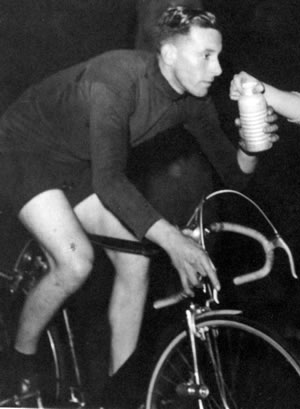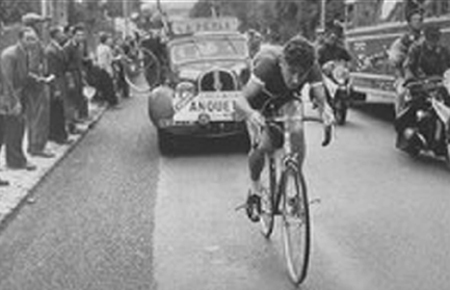How a single ride changed the face of British Time Trialing
 Mon, November 19, 2018
Mon, November 19, 2018  In England, in 1953, the top British time trialist was a man named Ken Joy. (Left.)
In England, in 1953, the top British time trialist was a man named Ken Joy. (Left.)
The previous year he had ridden a 100 miles in 4 hours and 6 minutes, which at that time was phenomenal.
In the early 1950s, British riders racing against the clock invariably rode on a single fixed wheel.
48 x 15, or 48 x 16 (86.4 inch or 81 inch.) would be a typical gear ratio used for 100 miles. Courses would be selected over the flattest possible terrain.
At the end of 1952 Ken Joy turned professional and was sponsored by Hercules, a large manufacturer of roadster bikes, located in Birmingham, England. As British time trialing did not have a professional category, the only thing open for Ken Joy, was to ride solo and attack the many place to place records and distance records under the auspices of the Road Records Association.
So when Ken Joy was invited to ride in the Grand Prix des Nations in 1953 it created tremendous excitement for the average British Club Rider. This famous French event was after all considered to be the unofficial World Time Trial Championship of Professional Cycling.
Britain was somewhat cut off and isolated from the rest of Europe as far as cycling was concerned. We were in our own little world of time trialing, and the time trials held on the continent of Europe were odd distances, and held on courses that were not always flat, so how did you compare.
There was much speculation in the weeks leading up to the event as to how well Ken Joy would do. After all he had to be in with a chance, 100 miles in 4 hours 6 minutes is not exactly hanging around, by any standard.
I was 17 years old at the time and in my second year of racing, mostly time trialing; I was definitely caught up in all the excitement. The Grand Prix des Nations was to be run over a distance of 142 kilometers, which was just over 88 miles, a distance that would suit Joy.
The event was held on a weekend, and a few of the major British newspapers had the results in Monday’s morning edition. However we had to wait until the following Wednesday when the “Cycling” magazine came out to get the full impact of what had transpired.
The event was won by a then unknown 19 year old French rider named Jacques Anquetil. Not only did he beat Ken Joy, he started 16 minutes behind the British rider and caught and passed him. A nineteen year old kid, just two years older than me, had trounced the best that Britain had to offer.
There were two British professional riders in the 1953 event; the other was Bob Maitland whose previous riding was mostly in NCU Mass Start Circuit Races. I seem to remember Maitland finished with a better time than Joy, but both were well down the field. Later in 1955, Bob Maintland did become part of the first British team to ride the Tour de France.

I remember well the above picture of Anquetil, low, aerodynamic, with his hands curled around the slim Mafac brake hoods. His mechanic standing on the running board of the following car with a spare bike on his shoulder. This was a whole different world, a whole different level of bike racing.
This one ride changed the face of British time trialing. Anquetil used a five speed free-wheel, with 14, 15, 16, 17, 18 cogs. With a single 53 tooth chainwheel; it gave him a top gear of 102 inches. This was the highest ratio mechanically possible at that time. Soon after British time trialists would abandon fixed wheel and use five speed straight up 14 to 18, and later 13 to 17 free wheels.
Jacques Anquetil of course went on to become one of the great cyclists of all time. Winning the Grand Prix des Nations 9 times, and going on to become the first man to win the Tour de France five times.
The Grand Prix des Nations which started in 1932, and became one of the professional classics, was held annually until 2005 when it was abandoned after the UCI inaugurated an official World Time Trial Championship.
Footnote: If you haven't already done so, read this 3 part series: The History of British Cycle Racing. It tells of the ban on road racing in Britain that lasted 50 years, and how a handful of cyclists fought to get this ban lifted. Britain's current success in cycling is due in part to those who went before and dragged the sport out of the dark ages





































